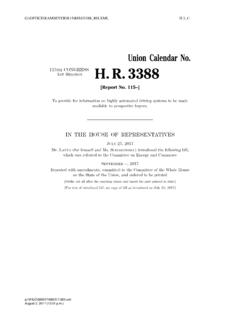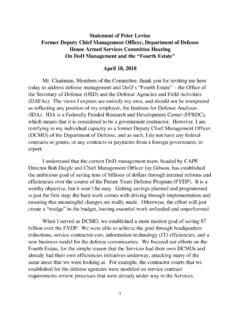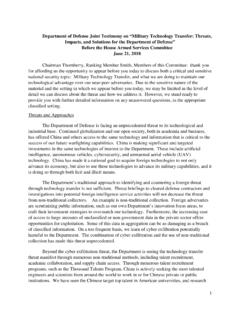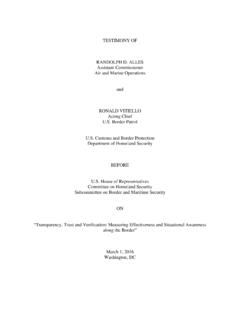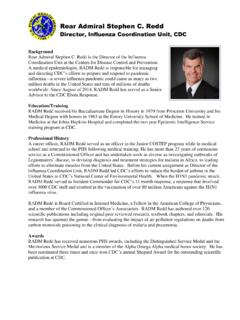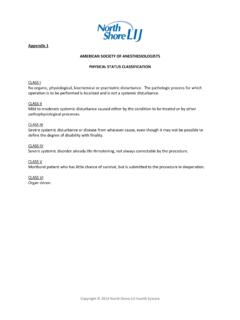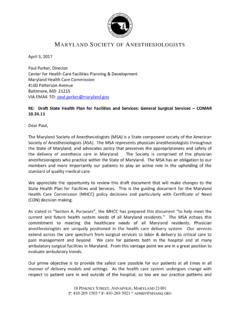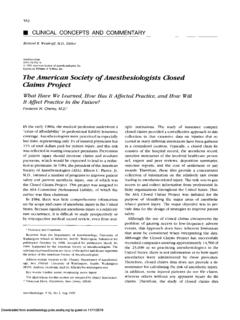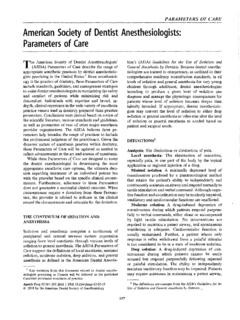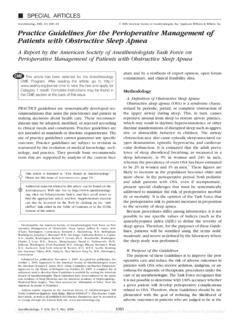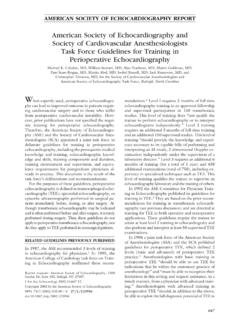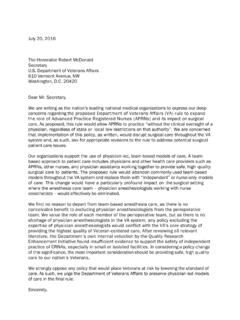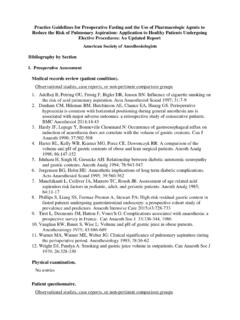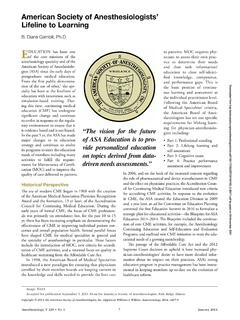Transcription of Statement for the Record Jeffrey Plagenhoef, M.D ...
1 Assessing VA s Risks for Drug Diversion Committee on Veterans Affairs Subcommittee on Oversight and Investigations February 27, 2017 Statement for the Record Jeffrey Plagenhoef, , President, american society of Anesthesiologists On behalf of more than 52,000 members, the american society of Anesthesiologists (ASA) would like to thank Chairman Bergman, Ranking Member Kuster and members of the Subcommittee for holding the hearing, Assessing VA s Risks for Drug Diversion, and providing ASA the opportunity to submit a Statement for the Record . We greatly appreciate your willingness to discuss this important topic and how it impacts our nation s Veterans. Physician anesthesiologists are health care professionals who manage and administer a large number of controlled substances in their roles as perioperative physicians, and are pain medicine specialists, diagnosing and treating patients with complex pain conditions.
2 As leaders in patient safety, anesthesiologists thereby are uniquely positioned to address this issue. ASA believes prevention of, and education about, drug diversion activities are critical. We look forward to working with the Committee and others on a multidisciplinary approach to minimize the potential for drug diversion and ensure patients in the Department of Veteran Affairs continue to receive high-quality care. It is no secret that the potential for drug diversion by clinicians, staff, patients, family members and others is a real threat at any hospital, surgery center, nursing home, pharmacy or other care organizations. News media and internal reviews, such as the February 2017 GAO report on controlled substance inspection programs,1 have played an important role in revealing some of these instances where health care professionals have diverted drugs for their own use, and in some cases, the patient fatalities that have been the result.
3 Moreover, a report by the Substance Abuse and Mental Health Services Administration (SAMHSA) illustrates that drug diversion contributed to a fourfold increase in substance abuse treatment admissions between 1998 and 2008 among individuals aged 12 and It is also widely known that certain healthcare specialties, such as anesthesiology, are associated with increased risk for abuse of and dependency on certain classes of drugs. For this reason, ASA feels strongly about identifying and adopting strategies that lead to successful drug diversion deterrence programs. As a result, 1 United States Government Accountability Office, Actions Needed to Ensure Medical Facility Controlled Substance Inspection Programs Meet Agency Requirements, February 2017, Available at: 2 The TEDS Report, Substance Abuse Treatment Admissions Involving Abuse of Pain Relievers: 1998 and 2008, July 15, 2001.
4 Available at: ASA s Committee on Occupation Health has created a model curriculum on substance use and disorder. This curriculum identifies the problem of drug diversion and addiction, specifically in the occupation of anesthesiology, detection, re-entry into the occupation, as well as As the Committee is aware, there are institutions that already implement successful drug diversion deterrence programs. In fact, some of these programs have been highlighted in testimony for this hearing. In addition, the Centers for Medicare & Medicaid Services (CMS) has resources describing the role of practitioners in preventing drug diversion. Furthermore, Congress and Federal agencies have taken important steps to curb opioid abuse and misuse. For example, during the 114th session, Congress passed the Comprehensive Addiction and Recovery Act (CARA), which included ASA-supported provisions to expand access to naloxone; allow patients to partially fill prescriptions for controlled substances; reauthorize NASPER, a public health grant program for prescription drug monitoring programs; and enable National Institutes for Health (NIH) to intensify pain research.
5 Additionally, the Centers for Disease Control and Prevention (CDC) issued the Guideline for Prescribing Opioids for Chronic Pain, which ASA collaborated with the agency to develop. There has been a heightened focus by regulators to tighten prescription requirements and work to change prescribing practices in response to the opioid epidemic. ASA is a long-time proponent of the use of multimodal, multidisciplinary pain management strategies including interventional techniques that will decrease reliance on opioids for chronic pain. While efforts to address the opioid epidemic are underway, there is a growing need to address drug diversion. ASA believes it is important to consider these alternative treatments as not only a method of decreasing patient reliance on opioids, but to also reduce the incidence of drug diversion.
6 The Drug Enforcement Agency (DEA) is heightening its scrutiny of healthcare organizations. As evidenced DEA s FY 2016 Performance Budget, there was a 9% increase in the budget devoted to Diversion It is no surprise that hospitals, surgery centers, nursing homes, pharmacies and other organizations will be held accountable for a lack of oversight and diligence when diversion occurs. Therefore, it would be prudent for health care providers, including anesthesiologists, to take preemptive steps to mitigate risks. As previously mentioned, there are already institutions implementing successful drug diversion deterrence programs and a lot to be learned from the information that already exists. ASA believes that training and education are integral to successful drug diversion deterrence programs. ASA recommends that all employees be educated on how to identify, detect and report potential drug diversion.
7 It is also important that they are able to do this anonymously, either through a telephone hotline or other immediate method. A limited number of health care professionals should also be properly trained on the use of automated dispensing units, with the caution that overreliance on these units can create a false sense of security. Multimodal pain 3 SUD Curriculum, ASA Committee on Occupational Health, Tetzlaff, John, November 12, 2015, Available here: ~/media/sites/asahq/files/public/resourc es/asa%20 4 Drug Enforcement Agency, FY 2016 Budget and Performance Summary, Available here: management techniques should be considered and employed whenever possible in order to reduce reliance on opioids. Additionally, policies and procedures should be developed with respect to waste/destruction of controlled substances and segregation of duties, including the ordering, receipt, inventory, storage, and stocking of controlled substances in different locations.
8 It is also advisable to frequently review drug management data, including investigating and reviewing discrepancies on a timely basis and conducting unscheduled reviews. ASA believes it is important to proactively take steps to mitigate the risk of drug diversion. Having procedures in place that inform every employee of the importance of preventing drug diversion, including disciplinary actions, can reduce risks. Even with certain safeguards in place, institutions are vulnerable. Therefore, it is important to work closely with and in cooperation with law enforcement, including local police and the DEA. ASA thanks the Committee for the opportunity to submit this Statement for the Record and would like to offer our members as a resource to the Committee, and also to emphasize our willingness to work with you and the Department of Veterans Affairs to address the issue of drug diversion.
9 Sincerely, Jeffrey S. Plagenhoef, President american society of Anesthesiologists



